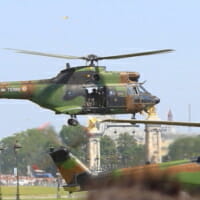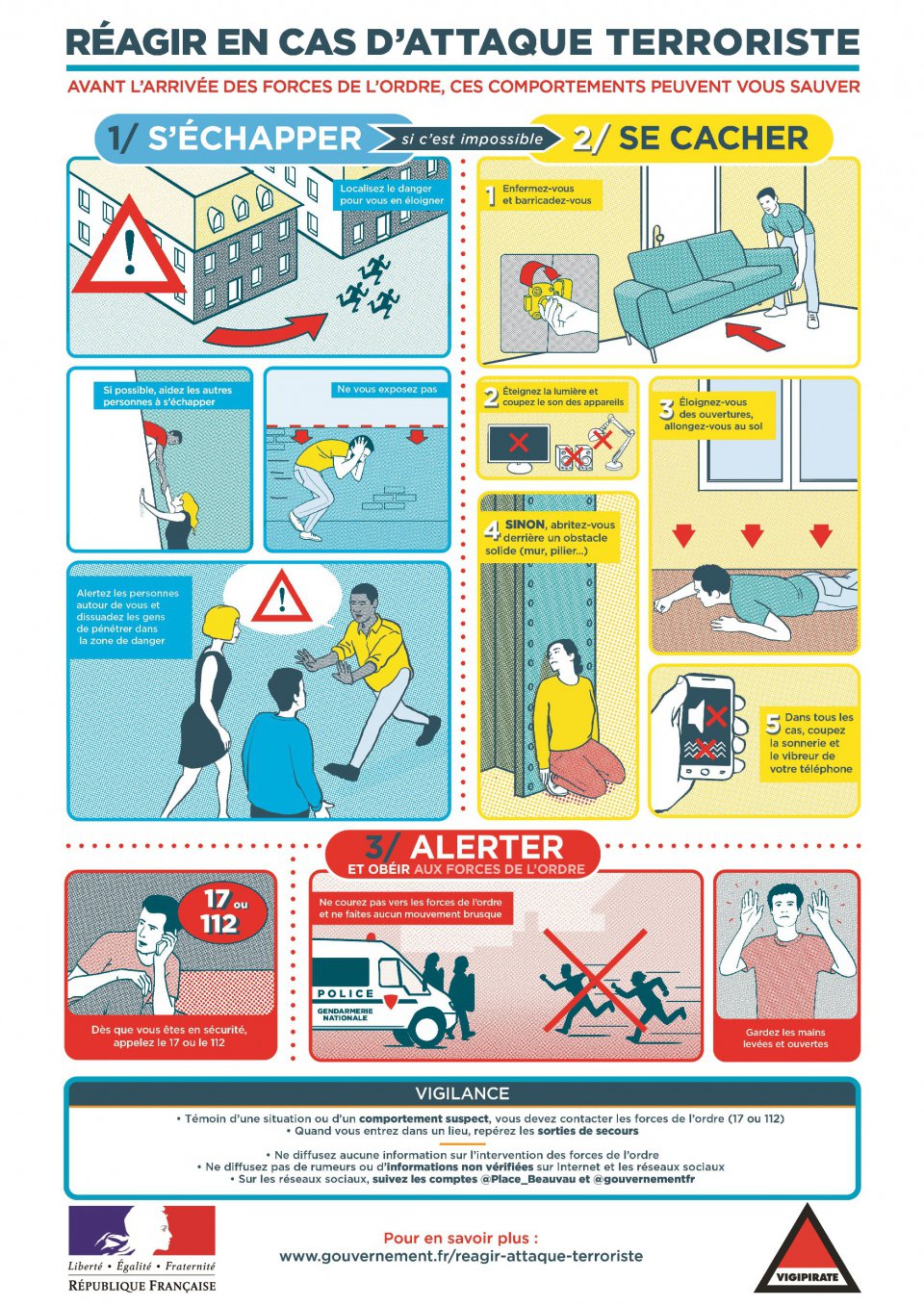Terrorist attack: what to do
What to do in the event of a terrorist attack and how to survive. Our specialty is synthesizing guides and arguments in the field of sales, marketing and business, but current events lead me to synthesize solutions in terms of safety, I also add my experience in combat sports whose principles are the same, whatever […]

What to do in the event of a terrorist attack and how to survive.
Our specialty is synthesizing guides and arguments in the field of sales, marketing and business, but current events lead me to synthesize solutions in terms of safety, I also add my experience in combat sports whose principles are the same, whatever the discipline. This article is based on a synthesis of French, American and Russian methods.
What to do in the event of a terrorist attack: the three Cs
In the event of a terrorist attack, you have to choose between three solutions, in order of priority: run, hide, fight.
Run
- Find the way out. The first thing to do when you arrive somewhere is to locate the emergency exits, just like on an airplane before take-off. Visualize the path to take, it doesn’t have to be complicated, the first few seconds of a terrorist attack are crucial to escape, people are usually in a state of shock or panic, a little preparation makes all the difference.
- In a restaurant or public place, you may prefer to sit with your back to the wall, so you can see who’s coming in.
- Get out as quickly as possible, whatever the advice of others. Too many victims confuse gunshots with firecrackers, so don’t wait until it’s too late. Exit by all possible means: emergency exits, windows, skylights. Many Bataclan survivors owe their lives to getting out immediately. If you hear the shooter playing with his breech, it may be that his gun has jammed or that he needs to reload.
- Leave your personal belongings behind – they won’t be a priority and will get in the way – same advice as on the plane.
- If possible, avoid the exits that everyone is taking: crowds can be more dangerous than the terrorist act itself.
- If there’s fire or smoke, crawl out: that’s where the purest, coolest air is. Having practiced this exercise in a dark room in the army, the important thing is to remain calm and let those in front pass quietly.
- You can take advantage of the fact that the terrorist is reloading his weapon to escape, but time is very short. Some misinformed websites claim that it takes 30 seconds to reload a Kalashnikov, but this is not true. A trained marksman needs just 4 seconds, as you can see in this video. Don’t stay in the terrorist’s line of fire, always run erratically in a zigzag pattern – it’s much harder for the shooter.
- Help others get out if you can.
- As soon as you have left the danger zone, prevent others from re-entering.
- If you’re in a car and stuck in a traffic jam, run out of the car.
- Call the authorities, remaining calm and stating your location.
Hiding
If you can’t get away, then hide – anything goes. Bataclan survivors were hidden everywhere: toilets, false ceilings, drains, closets. Here are the priorities:
- Hide from the terrorists.
- Avoid getting up and running if terrorists are around.
- If you’re in a room with terrorists, play dead if you can’t do otherwise, avoid any movement, any complaint, even if you’re injured. This is what saved many victims of the latest attacks at the Bataclan.
- Try to choose natural shelters that protect you from bullets; cardboard or plastic are not ideal.
- If possible, avoid places where you’ll get stuck.
- Locking doors is not much protection, but it can help.
- Never think you’re safe behind a door – it won’t stop bullets. Most of the brick partitions don’t stop Kalashnikov bullets either, so the soldiers reinforce them with sandbags. If the shots are coming from outside, hide in the middle of the building.
- If you’re caught in a shoot-out on the street and can’t escape, hide behind the engine blocks of cars.
Fight
 It’s the last option to choose, but sometimes there’s no choice if you see that terrorists are going to shoot at you or try to bring down the plane you’re on. Fighting is also the best thing to do if you find yourself with a terrorist in an enclosed space like a train, and if you’re close to him or behind him, provided of course that you feel physically and psychologically able to do so – which is how a massacre was averted on the Thalys. There’s no point in waiting: you’ve got nothing to lose by attacking.
It’s the last option to choose, but sometimes there’s no choice if you see that terrorists are going to shoot at you or try to bring down the plane you’re on. Fighting is also the best thing to do if you find yourself with a terrorist in an enclosed space like a train, and if you’re close to him or behind him, provided of course that you feel physically and psychologically able to do so – which is how a massacre was averted on the Thalys. There’s no point in waiting: you’ve got nothing to lose by attacking.
- Try to find other volunteers around you with the ability to fight.
- Try to prepare a simultaneous attack.
- Improvise weapons with whatever you have on hand.
- Get close to the terrorist(s) if you can, without being threatening. A few meters’ distance from them can enable you to attack extremely quickly, in a fraction of a second; a knife can be very effective against a terrorist with a firearm, as you’re faster than him with your knife if you take the initiative. Only a terrorist trained in aikido, jiu jitsu or commando techniques can cope. A knife can be replaced by any sharp object such as a screwdriver, awl, etc.
- Once the attack has begun, use all your strength, all your means and go all the way, don’t let up until the police arrive.
In all three cases, when the police arrive, listen to what they tell you, show them your hands, accept that you’re a potential terrorist, they don’t know if there are any hiding among the victims, they’re doing this for your safety.
Watch the American video of the 3 Cs: Run Hide Fight
The system proposed by the French government
The French government proposes a slightly “softer” variant: escape, hide, alert:
However, we clearly prefer the American version, because even if the French version is safer in point three, which calls for the police to be called, it’s not always applicable, and sometimes even dangerous.
As a last resort, sometimes you have to fight when there’s nothing left to lose. So, for example, it was by attacking the terrorists on the Thalys train that carnage was averted, and it’s also the only way out of a plane or public transport if it’s clear that the terrorists are going to take action and there’s no way to escape or hide.
How to fight a nerve gas attack
There are three categories ofchemical agents:
Vesicants such as mustard gas, used during the 14-18 war but also by the Islamists (and possibly Assad’s army) in Syria after plundering the Syrian army’s reserves. It chokes and attacks the lungs, but has nothing to do with the toxicity of nerve agents.
Suffocating agents such as chlorine, which is easy to find and has also been used in Syria.
The worst are nerve gases such as tabun, sarin, soman and VX agent. This is what scares our governments the most.
Nerve gases are spread by the wind and are often yellow or green in color. Try to escape from the cloud, taking into account its path with the wind. VX agent is colorless.
As these gases are generally heavier than air, a good form of protection – as opposed to bombing – is to climb hills or buildings.
Symptoms of VX include tears in the eyes, nasal discharge, excessive salivation and muscle tremors. VX attacks the nervous and muscular systems, and can cause death within minutes.
How to protect yourself from nerve agents
- The dry suit and gas mask, but they only work if you put them on before you’re hit, and it’s difficult to wear them for very long.
- If you are affected, get rid of your infected clothes and take a shower.
- Inject yourself with a dose of the antidote, atropine. Military personnel carry a self-injecting syringe, and we’ve just learned that participants in the forthcoming COP 21 meetings will also be equipped with one.
Where to buy protection suits, French army surplus site and wholesale site.
What to do if you’re taken hostage
- Avoid attracting the attention of terrorists.
- Don’t meet their eyes.
- Don’t respond to provocation.
- Stay calm.
- Don’t try to get up and leave if the terrorists don’t shoot the hostages.
- Locate the exits in case of gunfire.
What to do to survive a terrorist attack: avoiding the pitfalls
- Avoid opening parcels that arrive without knowing the sender.
- Never touch taut wires in places where they shouldn’t be.
- Beware of all doors and flushes. The soldiers avoid doors and cut holes in the walls to gain access to the houses.
- Never pass by freshly backfilled roadside areas.
- Don’t touch suspicious objects, children’s games or dolls in places where they shouldn’t be.
- In the event of an explosion, throw yourself on the ground, protecting your head with your arms.
This topic is fairly well covered by a Russian article from Sputnik
What to do with a suicide bomber
The basic rule is never to allow yourself to be approached by a suicide bomber. Even police officers wearing bullet-proof vests and protective gear can’t get close, as the explosion can be enormous.
Statistically, these are single men (without marriage) aged 17 to 30, the vast majority under 25. Their aim is to reach their target at all costs, and it’s very difficult to stop them.
Here are a number of signs that can help you identify them:
- The first thing you see is the silhouette, usually large enough to hide their belt or booby-trapped vest, or a bag they’re carefully handling.
- Clothing is usually loose-fitting to hide explosives, unless they’re hidden in a bag.
- Their eyes are haggard and vague.
- They’re in another world, they can’t hear what we’re saying to them.
- They sweat a lot.
- Some say their prayers before taking action (like Amedy Coulibaly at Hyper Cacher just before attempting an exit).
- More surprisingly, Islamists often wear flowery perfume to, they believe, ease their arrival in paradise.
What to do in the event of a terrorist attack
- Move away from him discreetly without letting him know you’ve recognized him.
- Try to position yourself behind him to warn those around.
- If you’re on a train or subway, change carriages without telling anyone, and notify the police, who may be able to arrest him before you reach your destination.

Conclusion
In conclusion, don’t be paranoid either, that’s what the terrorists are looking for, enjoy as before but with a little extra vigilance. If you’re scared, tell yourself it’s normal – you’re not the only one – and do some positive visualization, telling yourself that everything’s fine where you are.
And these little tips may help you feel safer and enjoy the moment.
Jean-Pierre Mercier
You can also access our management and business development training guides on this site.

